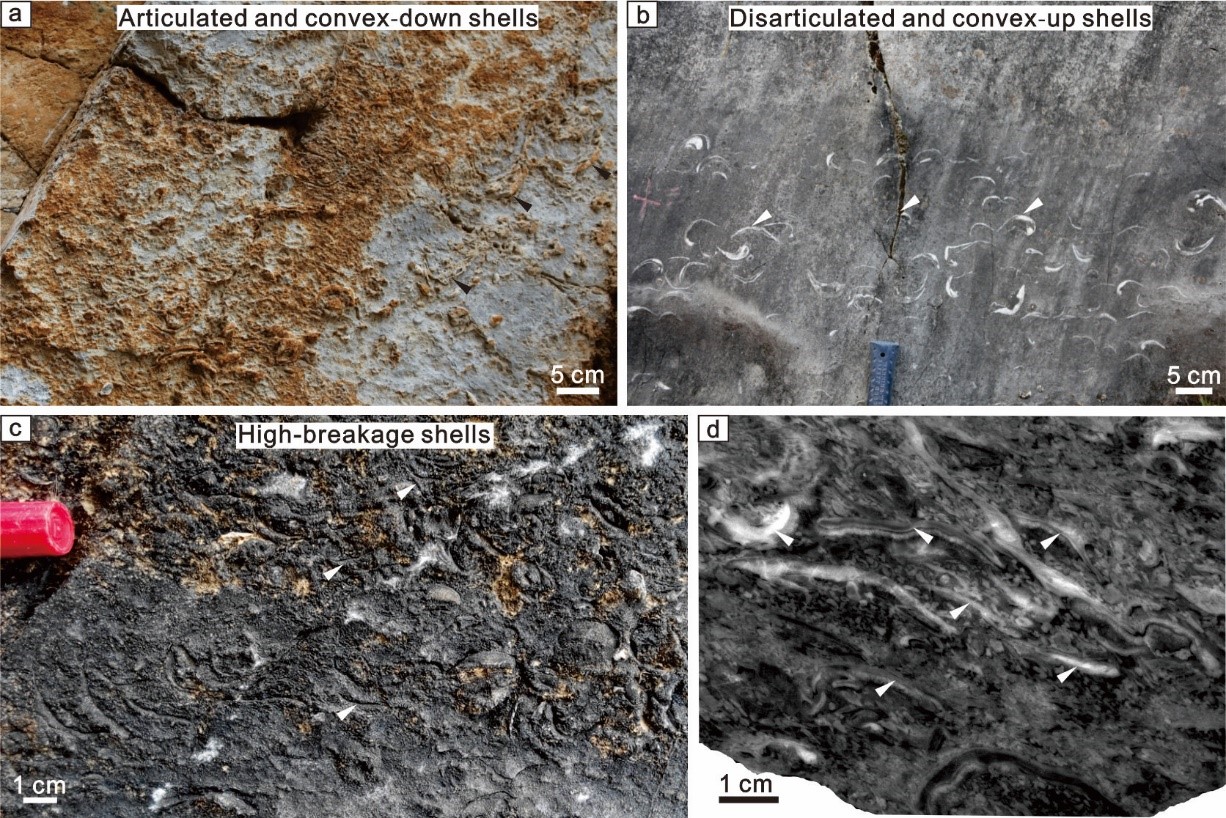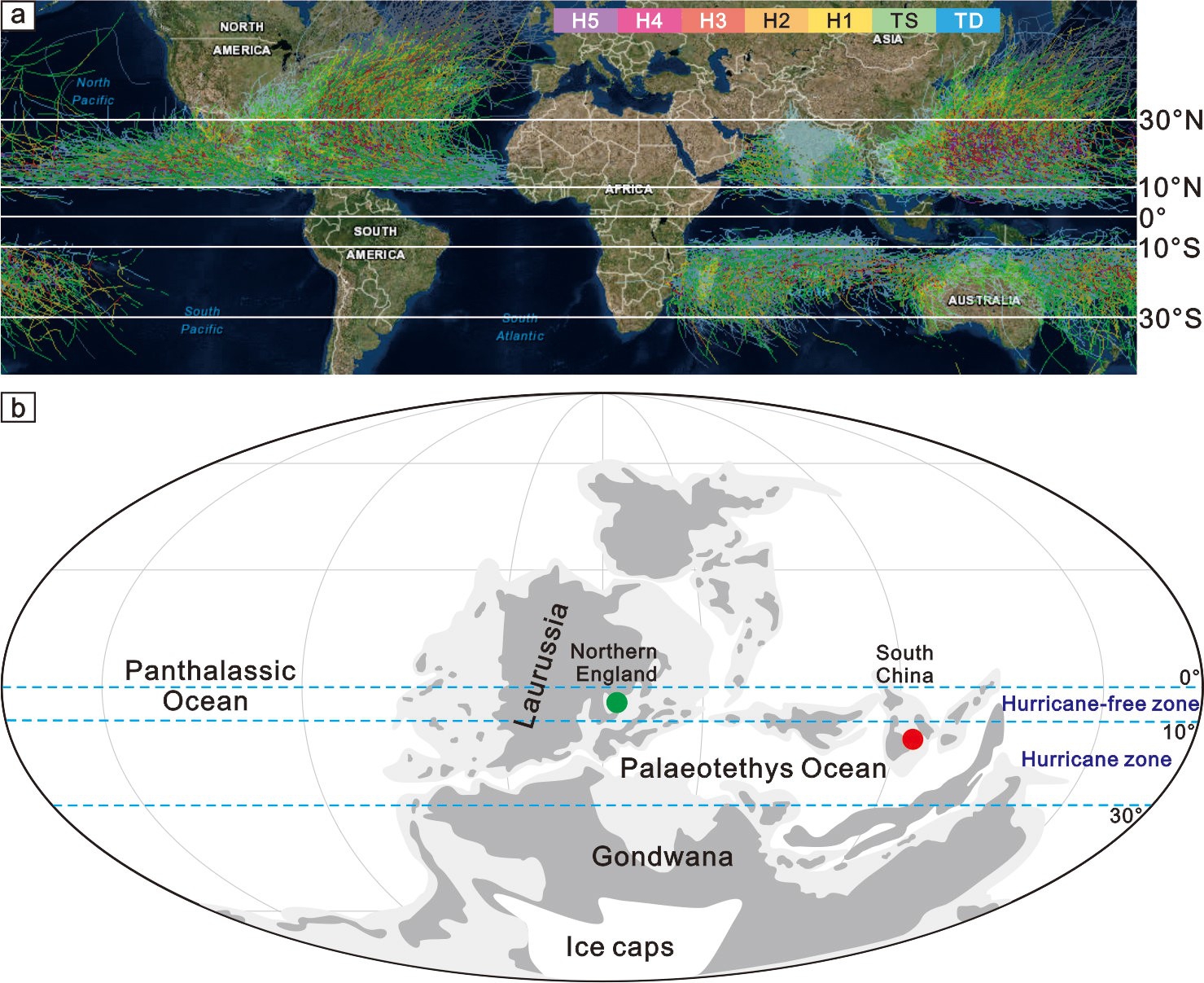
Field photographs (a, b and c) and polished slab (d) of three different taphonomic types in Gigantoproductus shell beds
Storm beds or tempestites are distinct facies criteria, which are generated by storm winds, such as cyclones and hurricanes in tropical latitudes and blizzards in middle and high latitudes. Storm shell beds, which are one common type of tempestites, were commonly formed in the tropical belt resulting from hurricane formation. According to the study on the relationships between taphonomy of shell beds and their palaeogeographical locations in the late Ordovician and its comparison with the modern hurricane distribution, it was found that non-amalgamated shell beds were located in hurricane-free zone within 10° of the palaeoequator, whereas, amalgamated shell beds occurred in hurricane zone between latitude 10° and 30°. The development of hurricanes is probably caused by the temperature difference between the high and low latitudes, induced by the occurrence of glacial deposits on the polar areas. At present, the South China Block is commonly believed to be located near the palaeoequator during the Mississippian, but its precise location is still unclear. In addition, the age of the glacial development on the Gondwana is also debated during this time.
To better understand the palaeo-latitude location of the South China Block and the age of the Gondwana glaciation during the Mississippian, the brachiopod (Gigantoproductus) storm shell beds were detailly documented from the Yashui, Duanshan and Gandongzi sections in South China by Dr. YAO Le from Nanjing Institute of Geology and Palaeontology, Chinese Academy of Sciences and Prof. ARETZ Markus from the University of Toulouse Ⅲ. The shell beds are characterized by sharp and erosional base, internal accumulations of amalgamated shells with erosional structure, and parallel lamination and ripple bedding structures in the uppermost part, indicating obvious characteristics of tempestites. In the shell beds, three taphonomic and sedimentologic types have been distinguished, which are: (1) mostly articulated and convex-down shells in wackestone and packstone, which are developed in distal tempestites with weak water energy around the storm wave-base; (2) dominated disarticulated and convex-up shells in packstone that occur between distal and proximal tempestites in medium hydrodynamic force between the storm wave-base and fair-weather wave-base; and (3) highly fragmented shells in grainstone formed in proximal tempestites under strong hydrodynamic energy above the fair-weather wave-base. The occurrences of proximal and distal tempestites suggest that they were formed by winnowing and transporting under storm surges. During the late Viséan to Serpukhovian, the widely distributed storm shell beds in South China reflect that the South China Block was located in hurricane zone between latitude 10° and 30° during this time interval, when ice caps formed on the Gondwana continent.
This paper was published in Geologica Belgica and financially supported by the National Natural Science Foundation of China, the Strategic Priority Research Program (B) of the Chinese Academy of Sciences and the Ministry of Science and Technology Foundation Project.
Reference: Gigantoproductid brachiopod storm shell beds in the Mississippian of South China: implications for their palaeoenvironmental and palaeogeographical significances.Geologica Belgica, 19/1-2: 57-67.

(a) Modern frequency and intensity map of hurricane tracks; (b) Locations of amalgamated shell beds and non-amalgamated shell beds in South China and northern England respectively, hurricane and hurricanefree zones and palaeo-latitudes during the late Viséan to Serpukhovian
